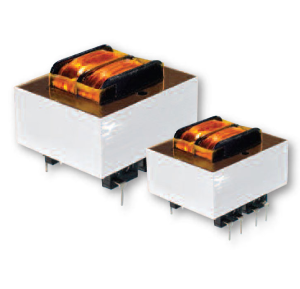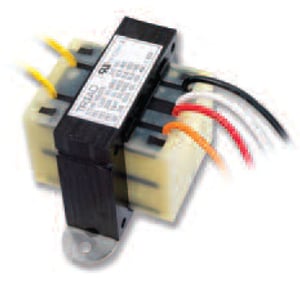Transformers are passive electrical devices that use magnetic induction to step up or step down incoming AC power voltage to match the voltage needed for the user’s electronic device. They are organized into classifications based on capability and performance level. Class 2 transformers are used for low-voltage circuit control, while Class 3 transformers are used in mid-voltage control applications.
All Class 2 and Class 3 transformers are either inherently or non-inherently limited. This means that the transformer's maximum output current is either limited by intrinsic coil impedance or a circuit breaker. In either case, these transformers are designed to meet the requirements of UL 1585-3.
What Are Inherently Limited Transformers?
An inherently limited transformer is designed to protect itself and the load without the need for a fuse or circuit breaker. When overload occurs, the transformer shuts down automatically. When the load returns to normal, the transformer will resume regular operation. Inherently limited transformers are self-limiting using impedance or in some cases positive temperature coefficient (PTC) devices.
In overload events, either the PTC will open or the transformer will saturate itself, without the need for additional fusing. Smaller class 2 transformers of 50 VA or less usually do not have circuit breakers or fuses, because the transformer is designed to saturate before the circuit overheats.
What Are Non-Inherently Limited Transformers?
A non-inherently limited transformer is protected by an external or internal circuit breaker or fuse. These designs feature a non auto-resetting fuse inside the transformer or in the circuit that opens under overload. When the load returns to normal, either the circuit breaker must be reset or the fuse must be replaced.
Non-inherently limited transformers rely on over-temperature and/or over-current protection to activate their fusing. While temperature fuses must be embedded in the transformer, circuit breakers or current fuses are not necessarily inclusive to the non-inherently limited transformer. Properly fused, Class 2 non-inherently limited transformers meet all UL1585-3 requirements.
What's the Difference Between Inherently and Non-Inherently Limited Transformers?
The basic difference between inherently and non-inherently limited transformers is that non-inherently limited designs feature a non-resettable fuse that opens when an overload occurs, whereas inherently limited transformers use impedance or PTC devices to fail safely in overload events.
In terms of meeting UL Class 2 requirements, there is no difference. Inherently and non-inherently limited transformers are interchangeable because UL certification relates to safety. Both inherently limited transformers and the fuses in non-inherently limited transformers are acceptable ways of ensuring device safety. UL only demands that transformers are appropriate for Class 2 applications and meet relevant safety requirements, such as those relating to limiting output current, output voltage, and output power.
What Are Inherently and Non-Inherently Limited Transformers Used For?
Because Class 2 transformers are used for low-voltage circuit control applications, Class 2 transformers are more common than Class 3. Both inherently and non-inherently limited Class 2 transformers can be installed in any low-voltage application that requires a Class 2 circuit, such as:
- HVAC systems
- Doorbells
- Lighting fixtures
- Home appliances
- Video systems
- Garage door openers
- Alarm systems
In comparison, Class 3 transformers are found in applications that require mid-voltage control, including:
- Security systems
- Public address systems
- Home theater sound systems
- Central alarm systems
At Triad Magnetics, we supply a broad range of Class 2 power transformers for diverse applications. You can learn more about Class 2 power transformers by downloading our eBook, Understanding UL Class 2 Power Transformers.
Triad class-2 control transformers come with tamper resistant shrouds for safety and steel brackets welded to the bottom of the transformer for ease of mounting.
Power Transformers From Triad Magnetics
While inherently and non-inherently limited transformers feature different types of overload protection, they both meet UL approval for safety and are suitable for use in a diverse range of low- and mid-voltage control applications. At Triad Magnetics, we have over 80 years of experience meeting the diverse needs of commercial, industrial, and consumer electronics.
The Triad Magnetics team constantly seeks new ways to improve on transformer technology. One such improved technology is our Triad Split Pack™ transformers.
We offer an extensive catalog of standard power transformers and also develop custom solutions for applications that involve unique operating conditions. Thanks to our global network of distributors and advanced computer inventory system, we are able to offer just-in-time delivery for every order. To learn more, contact our team or request a quote today.








